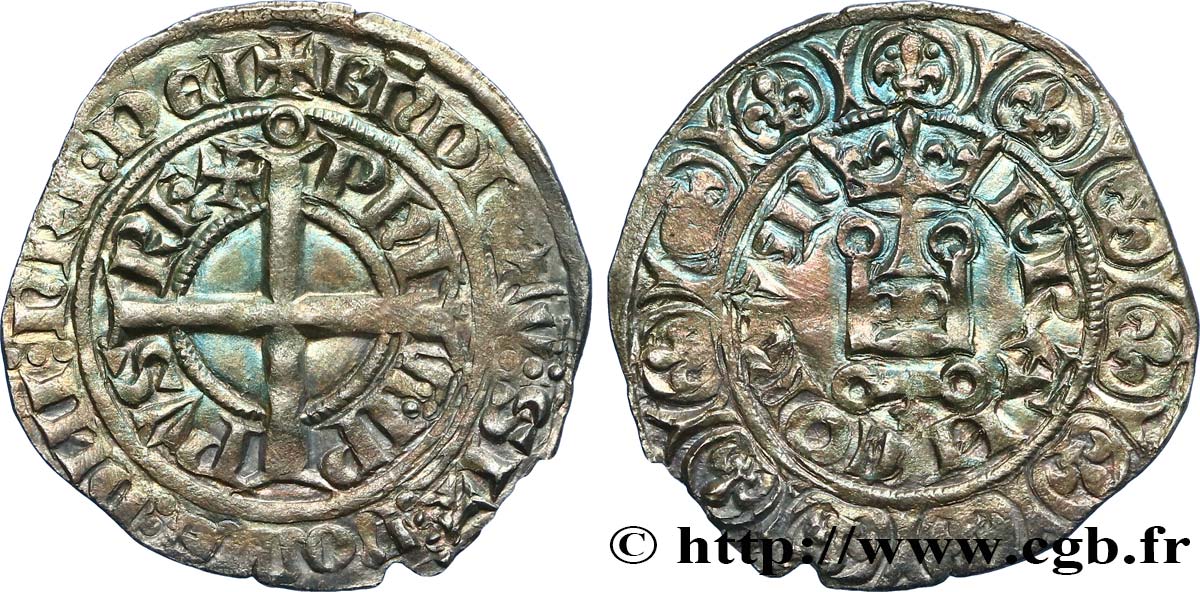正面
正面的文字 PHI-LIP-PVS-REX. (L TRÉFLÉE) ; LÉGENDE EXTÉRIEURE : + BNDI[C]TV: SIT: NOM[E:] DNI: NRI: DEI.
正面的说明书 Croix pattée coupant la légende intérieure, annelets aux quatre extrémités.
正面的翻译 (Philippe, roi ; Béni soit le nom du Seigneur).
背面
背面的文字 FRANCORVM.
背面的说明书 Châtel tournois meublé de trois annelets surmonté d'une couronne ; au-dessous, une étoile ; bordure de onze lis.
背面的翻译 (des Francs).
评论
历史细节
PHILIP VI OF VALOIS
(01/04/1328-22/08/1350)
Born in 1293, aged 35 on his accession to the throne in May 1328, Philippe was the son of Margaret of Sicily and Charles of Valois, who could be said to have been son, brother, uncle, son-in-law of king and never king himself. Other claims, however, arose to the crown of France: those of the house of Navarre, heir to the rights of Joan, daughter of Louis X, those of Edward III, heir to the rights of his mother, Isabelle of France, daughter by Philip the Fair. Edward III paid homage to Philip VI at Amiens in June 1329. However, in the following years, the incidents multiplied. Edward's war against the King of Scotland David Bruce kept the Englishman away from Guyenne for some time and Philippe, in 1336, went down to Avignon. Its fleet was preparing to operate in the Mediterranean. The following year, the situation reversed: the fleet went to the North Sea. War seemed near. On All Saints Day 1337, the Bishop of Lincoln, Henry Burgersh, came to Paris: he announced the rupture of the homage paid to Amiens, the questioning of the succession of France and the declaration of war. The Netherlands sided with England, the Count of Luxembourg and King of Bohemia, John the Blind, sided with France, Alphonse XI also. In January 1338, Flanders rose against Louis de Nevers and Jan van Artevelde, captain of Ghent, took over the government of the county. The following year, the Count of Flanders took refuge in Paris. The Flemings recognized Edward as king. Edward III then assumed the title of King of France and took up arms halfway between France and England.. On June 24, 1340, the French and English fleets met off the coast of Bruges, near the outer port of L'Écluse. The total defeat of the French gave Edward mastery of the sea. A truce was concluded at Espléchin the following September. The war resumed in 1345. A landing of Edouard in Flanders was short-lived. In 1346, Jean, son of Philippe, Duke of Normandy, attacked Guyenne and laid siege to Aiguillon. However, in July 1346, Edward landed in Cotentin and ravaged Normandy. Philippe set off in pursuit: the two armies clashed at Crécy on August 26, 1346. New and complete victory of the English, however inferior in number. Philippe flees; many of his great vassals fell on the battlefield. In 1347, Edward took Calais and established a garrison there. At the same time, a complex war of succession was devastating Brittany, where the English side had long had the upper hand.. The only success of the reign: the acquisition of Dauphiné de Viennois, ceded to the eldest son of the Duke of Normandy by Humbert II in 1349. When he died in 1350, Philip left a kingdom and a dynasty equally shaken.








 对产品描述纠错
对产品描述纠错 打印
打印 分享我的选择
分享我的选择 提问
提问 Consign / sell
Consign / sell
 产品介绍
产品介绍








